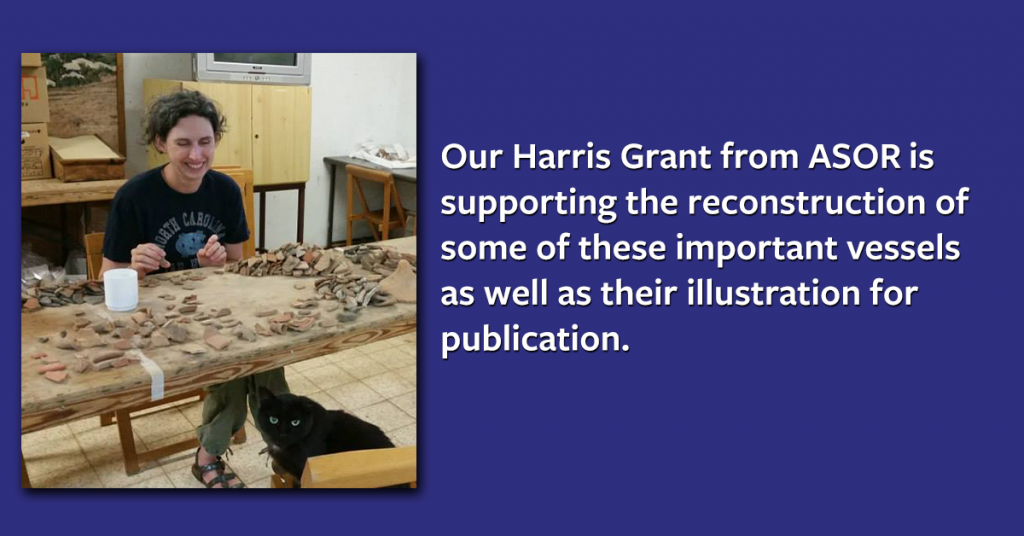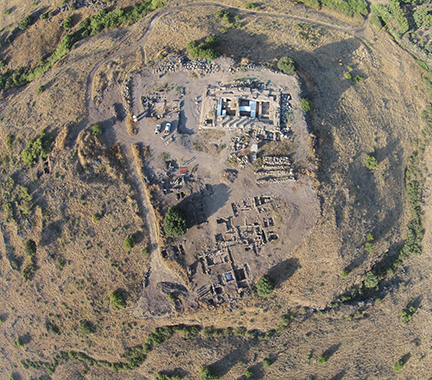How I Learned to Stop Worrying and Love the Pottery

By: Dr. Jennifer Gates-Foster Harris Grant Recipient
Our season this summer at the Omrit Settlement Excavation Project at Horvat Omrit in the Hula Valley was one filled with surprises. As we have in previous seasons we spent our time this year excavating in the area north of the large Roman temple previously excavated by Macalester College. Our project focuses not on the temple and its precinct (although of course we intersect with these areas to a certain extent) but in the area north of the temple where a large multi-period settlement was situated.

In previous seasons, one of our main research questions has centered on the chronology of the settlement, which has not been well-described in previous work at the site. My research has, in particular, focused on the pottery assemblages which were distinctive to each phase of the settlement’s history. Beginning in, we began to really sort out the pottery wares and shapes which mark each phase and this work continued apace insupported by a Harris Grant, which supported the reconstruction of several important vessels as well as pottery drawing and petrographic analysis.
One of the tricky aspects of this process has been characterizing pottery assemblages from periods that are not well-documented in the Golan. In particular, the period from the mid-1st century CE until the beginning of the third century—essentially the High Empire—has had no well-dated, stratified and published deposits from the region. The work of Andrea Berlin at Tel Anafa (and Tel Kedesh) offers an excellent snapshot of the Hellenistic period but her assemblage at Anafa stops in the early to mid 1st century AD, which appears to be the period when the Omrit settlement area really gets going. Primary assemblages at Banias pick up in the early third century so we’re left with a big gap in our understanding of what this period, roughly from the reign of the Flavians until the Severans, looks like in ceramic terms.
Inat Omrit we discovered the first of several deposits that (it is now clear) date precisely to this phase of the High Empire, and much more of this deposit was recovered. These groups contain a large amount of imported fineware, especially ESA, as well as other material that help us date them securely. As a result, we’ve assembled a relatively large body of evidence for the local coarsewares, cookwares and imported finewares of the High Empire in this part of the Golan region.

This summer and inwe spent considerable time doing the primary characterization of these deposits by sorting the pottery as it came in by excavation unit, and recording all the material by fabric and shape, including all body sherds. Our complete collection method means that we have recovered a large number of fragments of very small, delicate vessels including barbotine wares and thin-walled wares, which are characteristic of the first century AD. We also have recovered a healthy number of reconstructable vessels as well, meaning we will in future be able to present a dynamic assemblage of well-dated 1st-2nd c CE ceramic assemblages in their archaeological and architectural context. Despite the enormous amount of work this method of analysis entails, we’re excited that it has yielded such important results. Our Harris Grant from ASOR is supporting the reconstruction of some of these important vessels as well as their illustration for publication. We’re also carrying out petrography on many examples so that we can understand the sources for our local coarsewares and compare them to known kiln sites from the region. It’s pretty exciting stuff!!
Jennifer Gates-Foster is Assistant Professor of Classics at the University of North Carolina at Chapel Hill. She is co-director and ceramicist for the Omrit Settlement Excavation Project. She also works on Hellenistic and Roman pottery in Egypt and other parts of the Near East.
~~~
All content provided on this blog is for informational purposes only. The American Schools of Oriental Research (ASOR) makes no representations as to the accuracy or completeness of any information on this blog or found by following any link on this blog. ASOR will not be liable for any errors or omissions in this information. ASOR will not be liable for any losses, injuries, or damages from the display or use of this information. The opinions expressed by Bloggers and those providing comments are theirs alone, and do not reflect the opinions of ASOR or any employee thereof.
